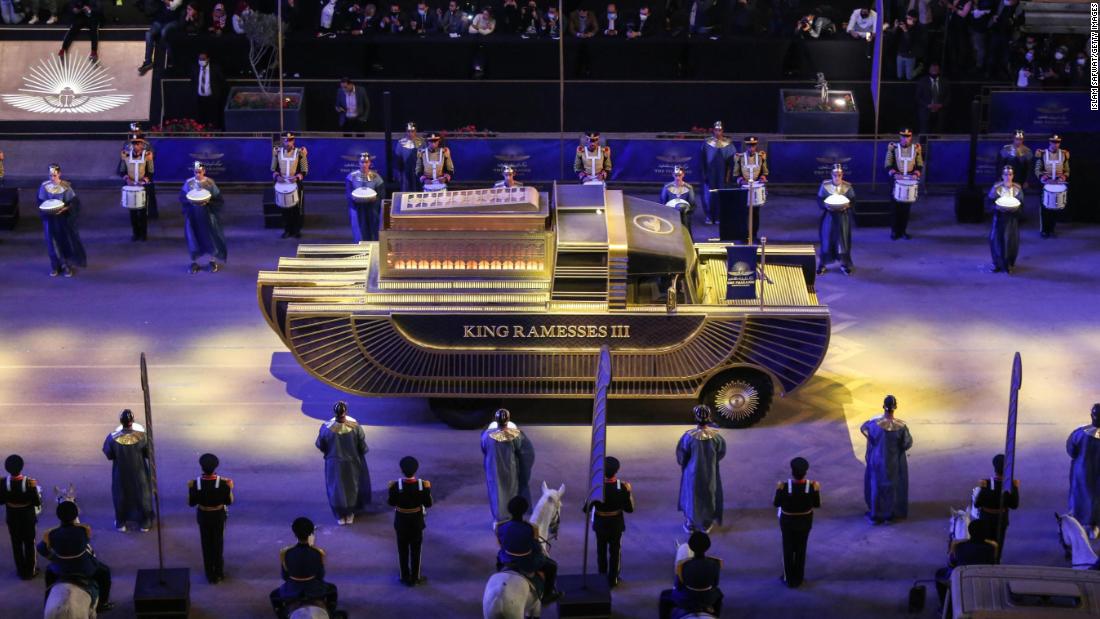
(CNN) – The ancient mummies of Egypt’s royal pharaohs left their resting places on Saturday and marched through the streets of Cairo to a new home.
What sounds like the plot of a movie was part of a lavish celebration of Egyptian history and a project to move some of its greatest treasures into a new high-tech facility.
The mummies of Ramses the Great and 21 other people were part of the “Golden Pharaoh Parade”, a highly anticipated event organized by the Egyptian Ministry of Tourism and Antiquities.
The parade took place between the Egyptian Museum, their old location near Tahrir Square, to their new home, the National Museum of Egyptian Civilization (NMEC) in Egypt’s first Islamic capital, al-Fustat.
“I invite all Egyptians and the world to follow this unparalleled event – evoking the spirit of the great ancestors who preserved the homeland and created a civilization in which all mankind is proud – to keep the path we began: the path of construction and humanity. “

The carriages carrying 22 ancient Egyptian royal mummies depart from the Egyptian Museum in Cairo’s Tahrir Square during the parade.
Khaled Desouki / AFP / Getty Images
Sarcophagi are stone coffins often adorned with sculptures and inscriptions.
Among the mummies are those of kings Ramses II, Seti I, Seqenenre and Tuthmosis III, in addition to four queens: Ahmose-Nefertari, Tiye, Meritamun and Hatshepsut.
The parade was greeted by 21 cannons and was joined by a military troop. The mummies were transported on special vehicles decorated with their names inscribed in the ancient Egyptian hieroglyphics, as well as in Arabic.
The mummies who took part in the parade were discovered in two caches. The first was unearthed in 1881 at Deir El-Bahari in the West Bank of Luxor in tomb TT320.
All 22 royal mummies come from the New Kingdom, a time when tombs were built underground with hidden entrances to drive away grave robbers.
Preparing the mummy
The purpose of the parade was to move the 18 kings and four queens of Egypt, along with their coffins and belongings, from their old house in the Egyptian Museum.

Performers dressed in ancient Egyptian costumes march at the beginning of the parade of 22 ancient Egyptian royal mummies leaving the Egyptian Museum in Cairo’s Tahrir Square.
Mahmoud Khaled / AFP / Getty Images
Dr. Mostafa Ismail, head of conservation at the Mummy Conservation Laboratory and warehouse at NMEC, led a team of 48 people to prepare the royal mummies.
The preservation process, he told CNN, involves placing each mummy in an oxygen-free nitrogen capsule, which can keep it preserved without being affected by the effects of moisture, especially when it comes to bacteria, fungi and insects.
The capsule is surrounded by soft material that distributes pressure and reduces vibration during transport.
When the mummies reach the NMEC, the display units will have exactly the same conditions as the nitrogen capsules. “So there will be no shock to the mummy when we take it out of the box and put it in these units,” adds Ismail.
Accompanying each mummy will be any things discovered with them, including their coffins.
The displays will also show CT scans that reveal what is under the packaging and sometimes any bone breaks or diseases that have affected kings.
CNN’s Taylor Barnes and Hamdi Alkhshali contributed to this report.